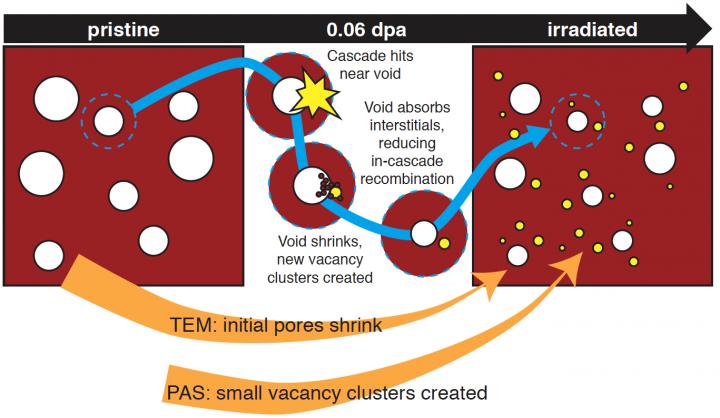Positron annihilation spectroscopy and transmission electron microscopy reveal new insights into radiation damage processes

Credit: Image credit, Los Alamos National Laboratory.
LOS ALAMOS, N.M., July 29, 2020–A multi-institution team has used positron beams to probe the nature of radiation effects, providing new insight into how damage is produced in iron films. This exploration can improve the safety of materials used in nuclear reactors and other radiation environments.
“Positrons do not damage the material and they can reveal defects involving single atoms at very small concentrations,” said Blas Uberuaga, a Los Alamos National Laboratory materials scientist on the project. “They are thus one of the most sensitive probes we can use to analyze radiation damage, providing critical data on the nature of the defects in the material and building our understanding of radiation effects.” Positrons, a form of antimatter, annihilate when they come in contact with electrons in the material, giving information about the local configuration of atoms.
Radiation damage occurs when high-energy particles smash into materials, knocking atoms out of position and creating defects in the crystal–either positions missing an atom or an atom in between, or interstitial, positions. This collision cascade is akin to a bowling ball slamming into bowling pins, except the ball may be a neutron and the pins are atoms. The defects that are created are ultimately responsible for failure of these materials in many extreme environments such as those present in the walls and various components of nuclear reactors. Thus, it is essential to understand how defects are created and behave in the material in these environments.
With thin films of iron as a model for steel, the team used ion beams–atoms accelerated in a laboratory–to mimic the type of damage that might be created in a reactor.
These films contained a high number of voids, or pores in the material. The team then used a combination of positrons and electron microscopy to look at the material before and after the ion beam damage. By combining characterization techniques utilizing positrons and electrons, they were able to interrogate both very small and much larger defects. Specifically, they were able to elucidate new mechanisms in which the voids already present in the material modified how damage was produced during the collision cascades.
###
This work provides new fundamental understanding of radiation effects that not only aids in the understanding of steels in reactors, but will improve scientists’ understanding of materials in extreme conditions more generally.
Video link: FUTURE, the Fundamental Understanding of Transport Under Reactor Extremes
The team included members from Bowling Green State University, University of California Berkeley, Los Alamos, North Carolina State University, Pacific Northwest National Laboratory, and the Helmholtz-Center Dresden-Rossendorf.
The paper: A New Mechanism for Void-Cascade Interaction from Non-destructive Atomic-scale Measurements of Ion Irradiation-induced Defects in Fe, Science Advances, S. Agarwal, M. O. Liedke, A. C. L. Jones, E. Reed, A. A. Kohnert, B. P. Uberuaga, Y. Q. Wang, J. Cooper, D. Kaoumi, N. Li, R. Auguste, P. Hosemann, L. Capolungo, D. J. Edwards, M. Butterling, E. Hirschmann, A. Wagner, F. A. Selim
DOI: 10.1126/sciadv.aba8437
The funding: This work was supported as part of FUTURE (Fundamental Understanding of Transport Under Reactor Extremes), an Energy Frontier Research Center funded by the
U.S. Department of Energy, Office of Science.
Video link: FUTURE, the Fundamental Understanding of Transport Under Reactor Extremes
About Los Alamos National Laboratory
Los Alamos National Laboratory, a multidisciplinary research institution engaged in strategic science on behalf of national security, is managed by Triad, a public service oriented, national security science organization equally owned by its three founding members: Battelle Memorial Institute (Battelle), the Texas A&M University System (TAMUS), and the Regents of the University of California (UC) for the Department of Energy’s National Nuclear Security Administration.
Los Alamos enhances national security by ensuring the safety and reliability of the U.S. nuclear stockpile, developing technologies to reduce threats from weapons of mass destruction, and solving problems related to energy, environment, infrastructure, health, and global security concerns.
Media Contact
Nancy Ambrosiano
[email protected]
Original Source
https:/
Related Journal Article
http://dx.




